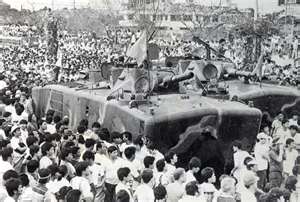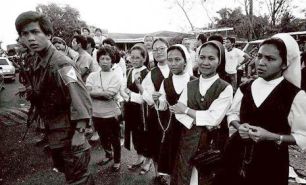The Marcos Dictatorship, Historical Remembrances, and Collective Memory
Today marks the 30th anniversary of the overthrow of Ferdinand Marcos and his authoritarian regime in the Philippines. From February 22-25, 1986, over two million Filipinos held demonstrations in the capital of Manila. The struggle against the two-decade authoritarian rule transpired for years and Filipinos expected a protracted and bloody revolution to bring down an entrenched dictatorship. Yet, unlike other sultanistic or neopatrimonial regimes that were defeated by a revolutionary movement or ousted by a coup d’état, Marcos was dethroned by nonviolent protesters, largely from the middle class, who were held together not by a common political ideology but by moral indignation founded on basic distrust of the government (see David 1985, Thompson 1995).

Named after the urban space in Manila where this historical watershed occurred, the EDSA “People Power” Revolution was the first democratic transition in Asia during the so-called “third wave of democratization” (Huntington 1991). It initiated a powerful “demonstration effect” and inspired activists in in Burma, China, and countries in Eastern Europe to try to overturn their authoritarian governments with nonviolent action. The EDSA Revolution has been the subject of studies on revolutions and democratization, often compared to the mobilizations in Iran and Nicaragua that led to the toppling of the Shah and the Somoza dynasty respectively (see Parsa 2000). Scholars ask why the Philippines only achieved regime change and not social revolution like the two countries. They explain the success of People Power in the Philippines in instituting regime change by focusing on (1) the breakdown of the state, especially on administrative and intramilitary conflict and withdrawal of external support; (2) the interplay between regime and opposition, particularly patterns and styles of state repression and the complexities of movement response; and (3) the relationship between civil resistance and armed struggle, specifically the tactical mistakes of the communist movement, the maneuvers of the democratic elite opposition, and the mobilization of the Catholic Church (see Boudreau 2004; Chenoweth and Stephan 2011; Foran 2005; Lee 2009; Nepstad 2011; Schock 2005; Thompson 2004).

I remember those four days in the last week of February 1986. I was seven years old, living in Ilocos region, the stranglehold of the Marcoses, where the dictator was considered a demigod. “Apo Marcos” (roughly translated as “Master Marcos”) as they called him. With media blackout and Manila a six-hour bus ride from our province, we had little knowledge about the unending and massive protests happening in the capital. I remember my brother and I getting upset for not being able to watch our shows because the only available television network was showing Marcos propaganda all day. When the protestors had finally taken control of the media and we saw the large gathering of people in EDSA and the eventual storming of Malacañang Palace, I remember all the adults in our neighborhood congregating and talking about how the communists and Cory Aquino will take power together and send all Marcos loyalists to jail. I remember a boy from my class telling me that military men will come to our house if we support Marcos, so I removed the “Marcos Pa Rin!” (“Marcos Still”) sticker in our gate when I got home. I remember asking my father: “If he is such a good president, why are the people so mad?” It was only when I went to graduate school and studied social movements that I understood, from a theoretical point of view, the contentious episode of 1986—and the years before that—that culminated in the ouster of Marcos and the return to oligarchic democracy.
Every year since then, the EDSA Revolution has been commemorated—with a celebratory tone in the first few years, often focusing on Aquino and the elites who opposed the dictator. This triumphant mood eventually dissipated and was replaced by anger. In the last decade or so, this anger has turned into outrage. Because not only did the People Power uprising restore power to the oligarchy, it also created the conditions for the children of Marcos’s ascent to elective positions at the national level. In the upcoming Philippine presidential elections in May 2016, Ferdinand “Bongbong” Marcos Jr. is running for vice-president, while his sister, Imee, for Governor of Ilocos Norte for the third time. A “betrayal” of what ordinary citizens regard as the true essence of EDSA—“the collective power of the people to fight tyranny and oppression”—is further seen in the longing of Filipinos for the purported “golden years” of Marcos, in light of problems associated with crime, corruption, and poverty. This yearning has resulted in the popularity of presidential candidate Rodrigo Duterte, who has no qualms calling himself a dictator and publicly expressing admiration to Marcos. A disturbing finding of a 2007 study on normative commitment to democracy using the Asian Barometer Surveys shows that pockets of support for authoritarianism is growing rather than diminishing in the Philippines.
Movement participants in the EDSA Revolution has seized the opportunity of the 30th anniversary to construct a collective memory of the uprising and the Marcos dictatorship, not only as a cure to historical amnesia and authoritarian nostalgia, but also as a means of reclaiming the “power to the people” that was lost with the proclamation of a member of a landed political dynasty as president, after the departure of the Marcoses. Collective memory helps bring the past into the present, strengthens protest identities, provides shared meanings to different social movements, and allows the imagination of alternatives to the current system. These former anti-Marcos activists have become “memory entrepreneurs,” who counter dominant discourses and persistent narratives about the authoritarian regime, revive past repertoires of resistance and recast their meaning based on the present, and institutionalize collective memory in material forms—such as museums and books—and representational practices.

Although political elites and activists mobilize annually to look back on the EDSA
Revolution, a “memory movement” has grown in the last year, with ordinary Filipinos coming out and sharing their own remembrances of the past. Through collective storytelling, participants of this movement exercise agency and motivate action. For instance, armed with personal accounts of persecution and abuse during Marcos’s rule, martial law victims dispute mythic tales about the regime through the “Campaign Against the Return of the Marcoses to Malacañang.” The group has used social media to engage the youth, who they regard as “mostly naive about what happened in the 1970s.” A blog called “Hindi Kami Ulyanin (We Are Not Forgetful): Remember 1081” publishes stories of disappearance and torture during martial law. Even Filipinos born after 1986 have shared their insights and responded to accusations of “millennial apathy.” In the Twitter world, the hashtags #NeverAgain and #EDSA30 feature a variety of voices from different subject positions. Indeed, the Internet has become a virtual meeting place for Filipinos to talk about the past—a discursive field that consists of contradictory and competing discourses that give meaning to events and processes.
But in the case of the Philippines, where a self-proclaimed dictator is the most popular presidential candidate and the son of a former dictator could be the first person in the presidential line of succession, the struggle for collective memory is more than just an annual occasion. It remains to be seen how far the memory movement can build on the momentum of the present to reconstruct the past for the future.
Read more on Mobilizing Ideas

